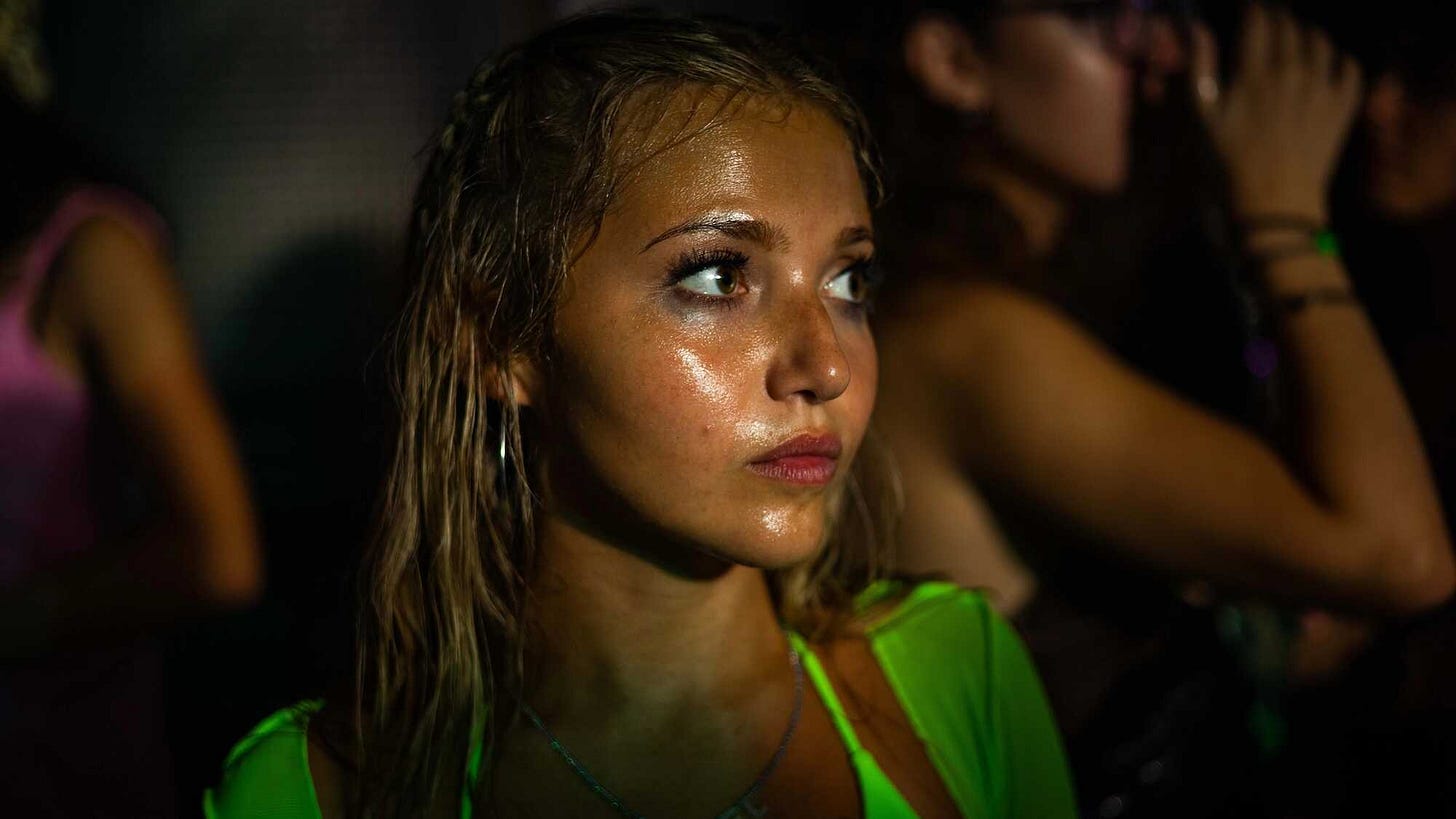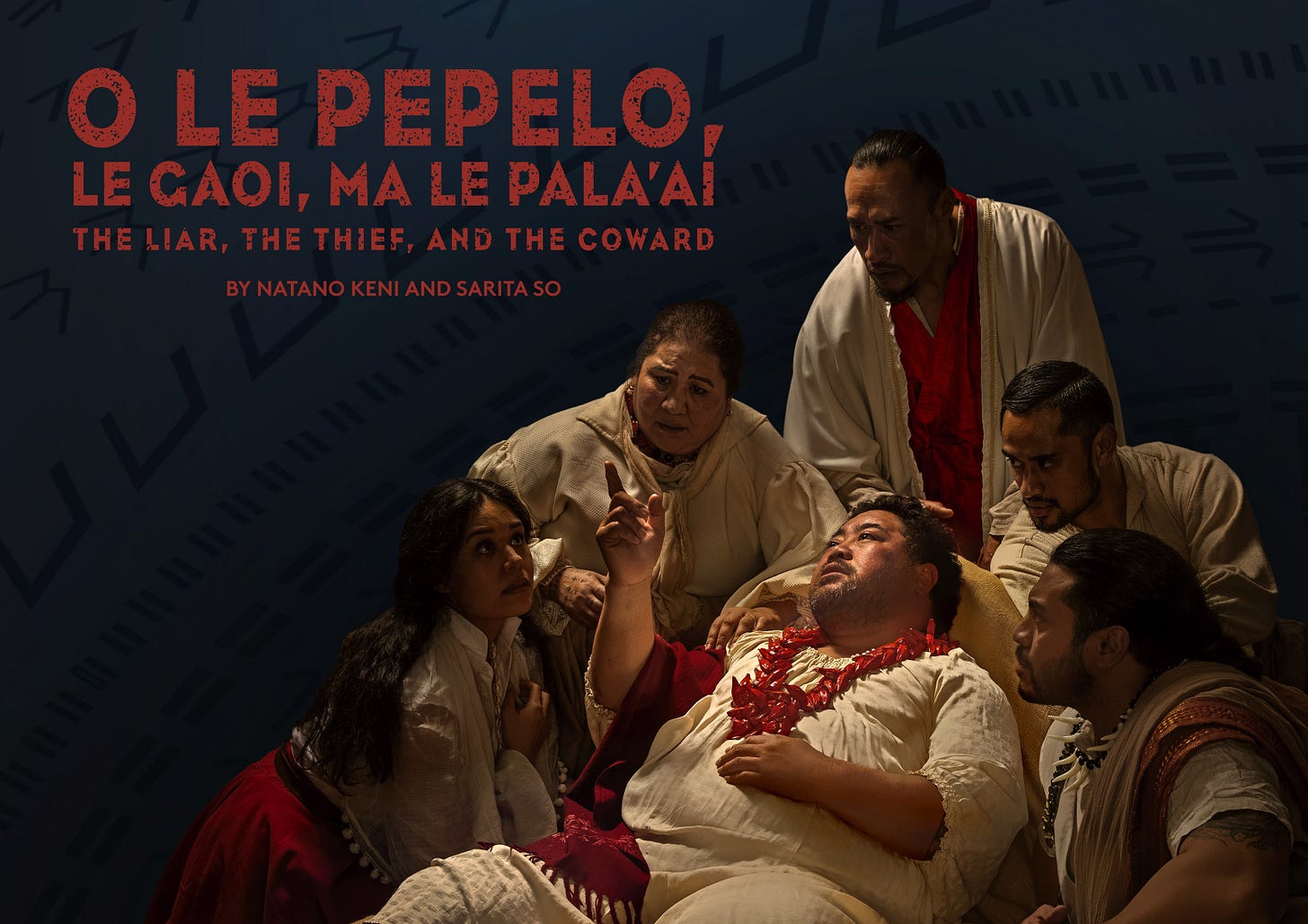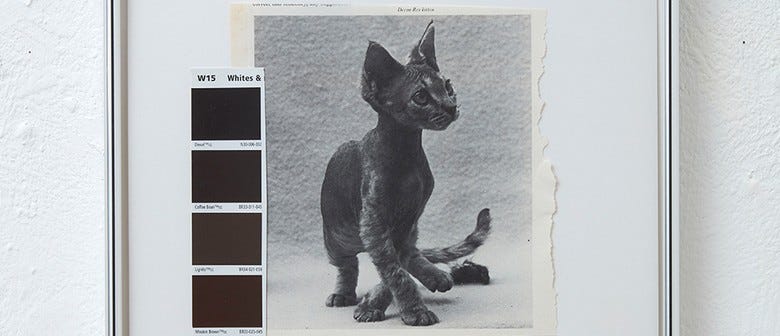East & West: 8/3/2024
Auckland Theatre Company's latest, grumblings in the media industry and an art gallery gig guide.
First things first, we’ve still got tickets to give away to the new film How to Have Sex, which is in cinemas as of yesterday. If you’re keen for a double pass, flick us a reply and we’ll see what we can do!
Last night the North & South crew attended the opening night of O le Pepelo, le Gaoi, ma le Pala’ai | The Liar, the Thief, and the Coward, a collaboration between Auckland Theatre Company, Auckland Arts Festival and I Ken So Productions.
Written by Natano Keni and Sarita So, and presented in both English and Gagana Sāmoa, the play opens with Pili Sā Tauilevā (Semu Filipo), a chief in the village of Moa, collapsing in his quarters. The family gather at Pili’s bedside to discover who will be declared his successor. Will it be the submissive, ambitious son, Matagi Puifatu (Haanz Fa’avae-Jackson), who has remained on the family land, running a chicken farm? Or haughty, combative Vailoloto (Ana Corbett), the prodigal daughter returned from New Zealand, where she was sent to live with Pili’s Kiwifruit magnate sister at age 11?
And what does either outcome mean for Pili’s wife Afinamumū (Aruna Po-Ching), daughter-in-law Afinamumū (Taofi Nehemia) and servant Tama’i (Villa Junior Lemanu)? Also circling the carcass are the village fool Vaofefe (Jesme Fa’auuga) — whose ribald commentary signposts the play’s Shakespearean overtones — and enterprising minister Kilifi (James Maeva), whose burgeoning church already holds Pili’s ear. But Pili withholds his decision, casting the household into turmoil. His son and daughter’s relationship, combative at best, sours further, and the village council is beginning to suspect something is rotten in the house of Sā Tauilevā.
Then a newcomer arrives, Masina Fa’asaogalemū, an orphan without birth claim, who dedicates himself to serving the conflicted clan. Masina sets the house to rights, brushing away superficial cobwebs to reveal the foundational rot that remains.
From this brief synopsis, you can anticipate the play’s thematic concerns: power, tradition, and ancestry. And the decline-of-a-patriarch stories it echoes: King Lear of course, but also, today, Succession. From the figure highest in stature — Pili — to the lowest — servant Tama’i — each character has their emotional journey, clearly and meaningfully impacting the course of events.
As expected from Auckland Theatre Company, the execution is sumptuous, combining elements of dance and digital projection with multi-dimensional stage design — we spoke to another attendee who had seen a barebones production last year at Wellington's Circa Theatre, and was excited to see what a bit of hard cash can do for a script this robust.
The family live in a three-tier house: level one for the servants, two for the family, and three for Pili and his wife. The characters weave in, around and through this monumental piece of scaffolding, enjoying the stage’s capacity for subtle, visual storytelling. The play’s dance components are introduced gradually, delicately preparing the audience for the night’s greatest tragedy, a moment of betrayal expressed entirely through movement and sound design.
The story of the corrupted gentry undone by external interlopers and internal hypocrisy, endures because it remains essentially hopeful. The family unit, of course, is a metaphor for broader society, and the possibility of cultural revolution exists in one interrupting figure’s capacity to push an already septic family into collapse. In this case, the three exploitations of Sāmoa's resources by the West — its people (labour), its environment (overfishing), and its culture (tourism) — are simply, movingly lamented through the tyranny of one patriarch and his heirs.
O le Pepelo, le Gaoi, ma le Pala’ai is a riveting drama — human, epic and surprisingly sharp — that North & South wholeheartedly endorse. It is on until 23 March, so check it out while you can.
The Ockham shortlist came out on Wednesday, featuring a surprising lack of (last year’s winner) Catherine Chidgey. Congratulations to the sixteen finalists, especially those nominated for debut books, including poets Megan Kitching and Isla Huia.
More big news in arts media this week was the announced hiatus of Pantograph Punch, after fourteen years. The Panto crew tried many avenues to sustain their publishing, including merchandise and subscriptions, but clearly it wasn’t enough. They write: “There are many systemic issues underpinning arts publishing. They are heartbreaking and have only gotten harder, not easier, to swim our way through — and we have had to make the immensely difficult, bittersweet choice to protect our platform and sustain its legacy.” The news forms a sickly one-two punch with last week’s Newshub announcement, and the TVNZ layoffs.
This news from Pantograph Punch reminds us of Contemporary Hum’s announcement late last month, which we didn’t cover at the time, that they would be switching to a new partnership (payola) model moving forward. This comes after they ran a notably aggressive fundraising campaign, successfully raising $30,000 to keep the lights on. In their announcement, CH wrote:
“…A lack of essential public funding has meant that Contemporary HUM has had to scale back its operations, but thanks to all those who supported our fundraising campaign on Boosted, we are able to stay afloat while we focus on strengthening our organisational foundations for the future and prepare to reapply for public funding at the next opportunity.
“Contemporary HUM's regular publishing programme is therefore suspended while we shift our focus to developing partnerships, both public and private, with the support of a reduced core team. We would like to acknowledge the care and dedication of our colleague Hamish Petersen, who so astutely stewarded HUM's publishing programme as Senior Editor throughout 2023. We aim to reinstate this role and our publishing programme once a source of core funding can be secured again.”
It’s hard to know how those who backed the campaign feel about learning that the money they chipped in will not go toward paying for original, independent art writing, but instead furnishing the incomes of Contemporary Hum’s senior staff.
In Auckland, head along to Te Uru on Saturday evening (4-6) for the opening of their new shows, highlights of which include Ava Seymour’s Domestic Wild and underfoot, a group exhibition “including works by Māori, Aboriginal and Pākehā artists from Aotearoa and Australia for which whenua (organic earth matter) is utilised in a range of poetic ways to quite literally give body and voice to the land.”
Tonight, visit Treadler (454 Karangahape Road, access via Cobden Street) for Shiraz Sadikeen’s The Natural Rate.
Tomorrow, at Sumer, see painter (and member of The Dead C) Michael Morley’s exhibition After the War.
The new Circuit Artist Moving Image project Wild Wild Life is open as of yesterday, featuring new commissions by a whole slate of contemporary video artists, including recent North & South contributor Tia Barrett. From Circuit: “Check out the series of seven new artist videos developed in response to the city of Tāmaki Makaurau Auckland, installed at site-specific locations across the inner city as part of Te Ahurei Toi o Tāmaki Auckland Arts Festival.”
And next week, on Friday, March 15, photographer Nicole Brannen’s exhibition Shadow Damage opens at 127 Newton Road Eden Terrace (underneath the Black and White Box).
Finally, if you’re down in Wellington, Richard Killeen’s new exhibition Banners opened at McLeavey Gallery on Wednesday. That’s on until the end of March.






